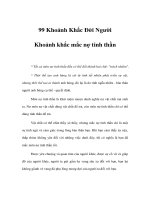No sooner than hardly when
Bạn đang xem bản rút gọn của tài liệu. Xem và tải ngay bản đầy đủ của tài liệu tại đây (12.2 KB, 1 trang )
No sooner … than, Hardly…when
If the second event occurs immediately after the first, we can express that idea using the structure no sooner …
than.
Note that in this structure no sooner introduces the event that occurred first.
No sooner had I arrived at the station than the train came. (= I came first and the train arrived right after
me.)
No sooner had we heard the noise than we rushed to the spot.
No sooner had she finished one project than she started working on the next.
No sooner had I closed my eyes than I fell asleep.
Note that did is also possible in this structure.
No sooner did I arrive at the station than the train came.
No sooner did we hear the noise than we rushed to the spot.
Notes
When we begin a sentence with a negative word, we put the auxiliary verb before the subject.
No sooner had she read the letter than she started crying. (NOT No sooner she read the letter than she
started crying.)
Note that when and before are not possible in this structure.
Hardly and scarcely
It is possible to express the same idea using hardly/scarcely…when.
Hardly had I reached the station when the train came.
Scarcely had I reached the station when the train arrived.
As soon as
This structure is also used with the same meaning.
As soon as I arrived at the station, the train came.
As soon as she finished one project, she started working on the next.
Stay on top of your writing! Download our grammar guide from www.englishgrammar.org to stay up-to-date.
Powered by TCPDF (www.tcpdf.org)









